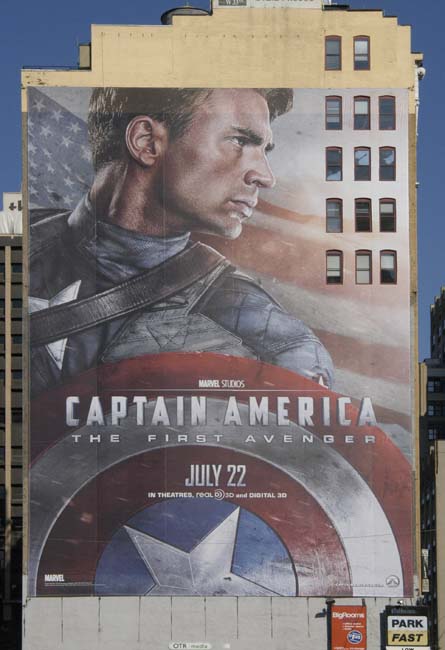I previously reported on an interview with Joe Simon and added that I thought there would be more coming out. Actually one appeared in Comic Book Resources a while ago but escaped my attention. A more recent one is in ABC News/Entertainment. With the recent release of the movie Captain America, the First Avenger it is not surprising that Joe is getting a bit of attention lately.
Category Archives: 2011/07
The Golden Age of Captain America, Syd Shore and the War Years

Captain America #21 (December 1942), “The Creeper and the 3 Rubies of Doom”, pencils by Syd Shores, inks by Vince Alascia (signed)
As mentioned in my previous post Captain America #19 was the last issue that Al Avison appeared in before going off to perform military service. Syd Shores assumed Avison’s position as Associate Editor while Stan Lee remained, for a time, Managing and Art Editor. While I admit to being critical of Shores as an inker his pencils are rather nice although not quite as good as Avison. There seems to be quite a bit of problems in the GCD concerning work attributed or misattributed to the two artists. I am not expert in identifying Timely artists but one feature that can often be used to identify Shore’s Captain America and Bucky are the exaggerated flaring that he provides to the folded portions of the boots. Syd’s handling of fore and background figures make interesting compositions. Shore also used extreme perspectives although not without some problems.
Now that Shores has become the primary Captain America artist his inking chores were handed off to others. Most, if not all, inking of Syd’s pencils was done by Vince Alascia. I do not believe that Alascia was part of the original Simon and Kirby shop. Since at the time most comic book artists were young most of them ended up in the military. Timely was very lucky to get someone of Alascia’s obvious talent. While Alascia used fine lines in his inking he never seemed to get obsessed with detailed inking like Shores did. In my opinion Alascia was a much finer inker than Shores.
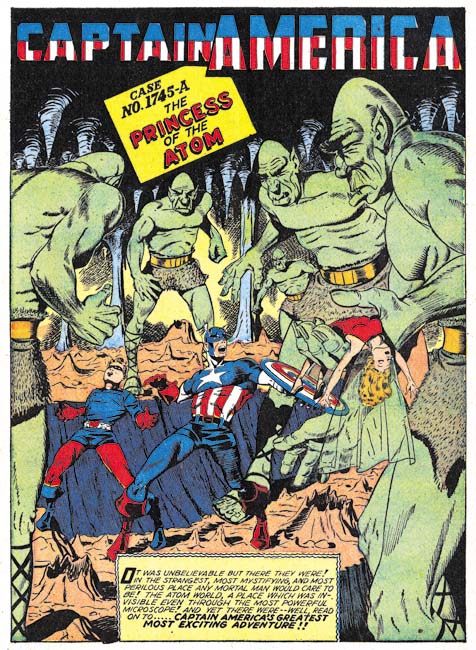
Captain America #25 (April 1943), “The Princess of the Atom”, pencils by Syd Shores
Captain America stories could be quite lengthy with 20 page stories not being at all unusual. However “The Princess of the Atom” is quite exceptional in being a two part story; the only one I am aware of from Captain America Comics. With a combined length of 46 pages it is effectively a comic book novella. It is an imaginative and captivating story and could have replaced “Red Skull’s Deadly Revenge” as my favorite post S&K Captain America story if not for the fact that I have never been able to read the second part. Atlas Tales lists Ray Cummings as the writer of this story. Apparently it is a recycle of his novel “The Girl in the Golden Atom”. This is welcome information as so few golden age comic stories can be attributed to a specific writer.
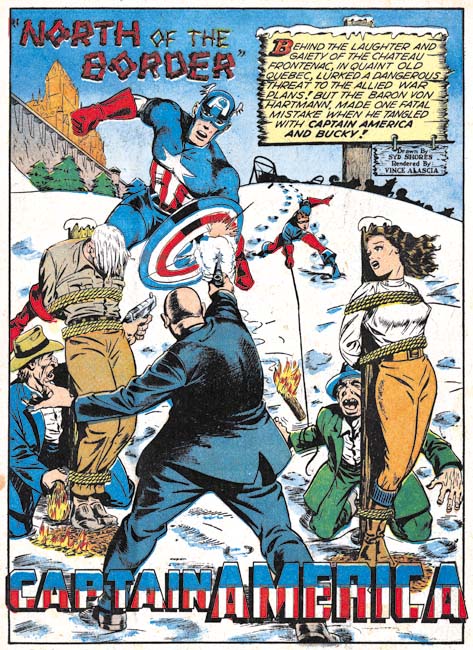
Captain America #27 (June 1943), “North of the Border”, pencils by Syd Shores, inks by Vince Alascia (signed)
Another example of Syd Shores inked by Vince Alascia. A classical triangular composition with Cap at the apex. However the triangle is offset from the center to allow the placement of the caption which is rendered as a wooden sign.
I do not have access to all the Captain America issues, but #22 lists Stan Lee as the Editorial and Art Director and Syd Shores as Associate, #25 provides no credits and #27 lists Vince Fago as the Managing Editor with Syd Shores continuing as the Associate Editor. Stan Lee had started his military service. Normally an artists entering the military would be considered a period where his contributions to comics would end. Simon and Kirby created a backup of material for DC but I am unaware of any other artist doing that. I could swear that I have seen a story with PFC Stan Lee credits (Private First Class) however I have been unable to relocate the source of that information.
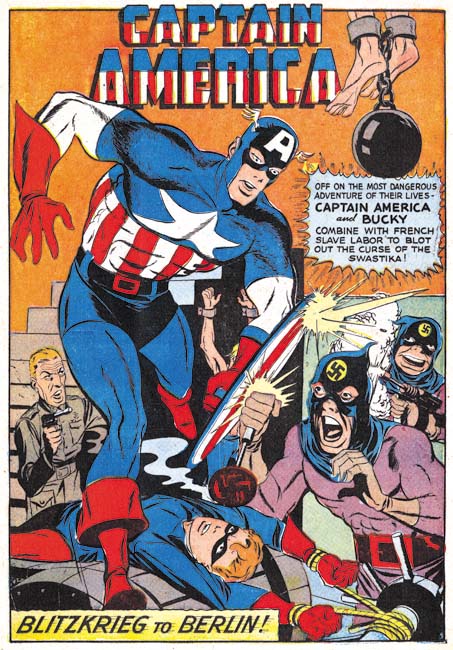
Captain America #27 (June 1943), “Blitzkrieg to Berlin”, pencils by unidentified artist
When Al Avison was the primary artist he seemed to draw most if not all the Captain America stories. But that does not seem to have been the case when Syd Shores became lead artist. Other artists sometimes did the backup Captain America stories and it seems they did so more often in later years. “Blitzkrieg to Berlin” is an example of one artist who appeared to have done a number of Cap stories. Note the very different figure proportions, the simpler faces and the much larger rendering of Captain America as compared to Syd Shores. Other than Shores most of the Cap artists did not sign their work so it is not clear who did this art.
“Blitzkrieg to Berlin” is one the few stories from the period covered in this chapter that I have seen where Captain America actually goes to war although in this case he joins up with some French resistance fighters. A Timely Bonus provides another example at Cap fighting in the war. As before Captain America was much busier combating spies than playing the part of a super soldier.

Captain America #33 (December 1943), “Mother Wong”, pencils by Syd Shores
While unsigned “Mother Wong” appears to be the work of Syd Shores and Vince Alascia. I do love these Captain America splashes. With the exception of a few double page spreads the splashes are invariably take up a full page. These generous splashes were put to great use by the creative talents of Avison and Shores. Even some of the backup artists could be quite impressive.

Captain America #34 (January 1944), “The Cult of the Assassins”, pencils by Syd Shores, inks by Vince Alascia, script by Zac Gabel (signed)
Writer credits, other than for Stan Lee, are so rarely provided that a special note is warranted for the credit to Zac Gabel provide in the splash of “The Cult of the Assassins”. Unfortunately very little is known about Gabel. All I have been able to find so far is that Who’s Who lists him as doing work for Holyoke as well (Blue Beetle, Green Mask and the Grey Mask). One wonders if he is the same Zac Gable who wrote the play “Horse Fever” (November 23 to December 14, 1940)?
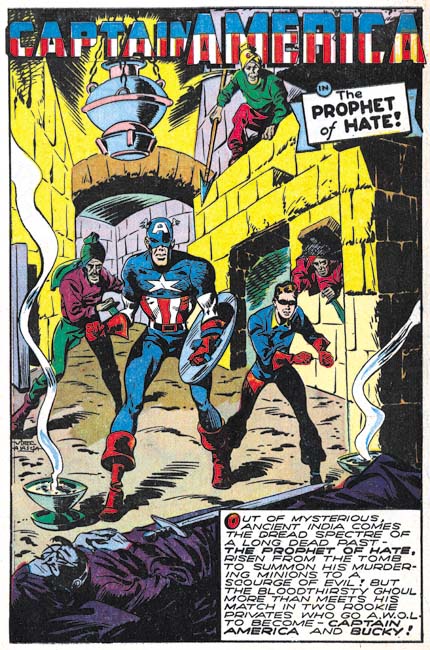
Captain America #44 (January 1945), “The Prophet of Hate”, pencils by Vince Alascia (signed)
Vince Alascia inked most, if not all, of Syd Shore’s art but he was a penciller as well. Vince was not as talented draftsman as Syd but his work still was interesting. Note the background figures threatening Captain America and Bucky. This sort of motif was often used by Simon and Kirby. Since this was a device not used by Avison or Shores it seems reasonable to assume that Alascia had seen and admired Joe and Jack’s work. The inking is done by a blunt brush very different from the inking that Alascia used on Shore’s pencils. Was it inked by someone else or did Alascia adopt a finer inking style to satisfy Shore?

Captain America #47 (June 1945), “The Monster of the Morgue”, pencils by Vince Alascia
“The Monster of the Morgue” is unsigned but the style looks the same as that Vince Alascia used for “The Prophet of Hate” so I attribute this work to him as well. This splash also has a figure with a weapon in the background a motif often used by Simon and Kirby.
I do not have access to many Captain America Comics from this period and it will be probably be years before Marvel’s golden age archives reaches up to the end of the war. Nonetheless next week I hope to discuss Captain America from the period just following the war.
Joe Simon Sees Captain America
I had the privilege last night of accompanying Joe Simon to a private screening of the soon to be released “Captain America, the First Avenger”. Joe had previously been invited to tour of the London filming set and to the Los Angeles premier but declined because the traveling would have been to difficult at his advance age. However his grand-children did go to Los Angeles for the movie’s premier although I have not heard yet how that went. Since he could not travel it was really nice that they arranged for Joe to attend this private screening. A good time was had by all. Joe has poor hearing so I was not surprised to hear him remark that he could not hear much of what went on “but that was okay because there was plenty of action”.
I will not review the movie since I am too much a Captain America fan to provide an unbiased assessment. I will say that not surprisingly the movie deviates from the comics as did the previous Hulk, Iron Man and Thor movies. However I really impressed by the numerous references to the comics. The writers clearly knew their comics and were not just ignoring them. Stan Lee does make a cameo appearance as he does in so many of the Marvel movies. The end credits included “based on the Marvel Comics by Joe Simon and Jack Kirby”. A special thanks section also listed Joe, Jack, Stan and three others.
With all the attention that the movie is getting, Joe has been giving some interviews. The A.V. Club has one interview but I believe there will be more.
The above image is a limited edition poster that was provide to participants of the making of the movie. But they were also kind enough to send Joe a copy as well. Captain America punching out Adolph Hitler. Where does Hollywood come up with such great ideas?
Negro Romance Comic on NPR’s History Detective
PBS has a weekly show where the show’s detectives try to uncover the history behind various artifacts. Last week they were presented with a coverless copy of Negro Romance Comics. I had known about the existence of this comic but because comics specifically aimed at African-Americans were so rare and are now so sought after, I have never actually seen a copy. Not that it ever occurred to me that there would be any connection between Negro Romance Comics and my main focus, Simon and Kirby. However it turns out that the art for Negro Romance Comics was done by Alvin C. Hollingsworth. Now the reader can be forgiven if that name does not ring any bells because while he did work for Simon and Kirby it appears he only provided art for four stories. Despite this limited amount of work, Joe Simon still remembers Hollingsworth; probably because there were so few African-American comic book artists then. You can see examples of his work in It’s A Crime, Forgotten Artists and The Captain Aero Connections. The History Detective episode can be viewed on PBS’s web site but be sure to scroll down to the bottom where scans of one of the stories from Negro Romance Comics is presented.
The Golden Age of Captain America, Al Avison
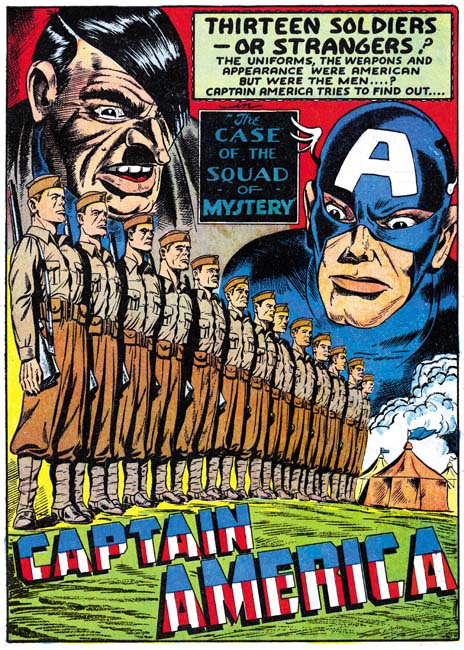
Captain America #11 (February 1942) “The Case of the Squad of Mystery”, pencils by Al Avison
Any discussion of Captain America really should start with those issues that Simon and Kirby created. Not only were they the creators but during the golden age of comics nobody did Captain America like Simon and Kirby. However I am not yet ready to cover Simon and Kirby’s Cap in a manner the material deserves. Instead I will pick up after Joe and Jack were summarily dismissed, that is once they had completed issue #10. But when they left Timely, Simon and Kirby left behind the staff that they had put together. Stan Lee, previously little more than a gopher, became the editor, Al Avison became the associative editor and primary artist, and Syd Shores would do the inking. All were pretty new to the business but Avison had also been doing some work for Harvey Comics and the experience made him a better artist (Al Avison on Speed, Avison Takes on More Speed, Speed Comics #16, Pocket Comic #3) . Actually Avison’s work for Harvey seems comparatively primitive and his talent seemed to blossom once Simon and Kirby were gone.
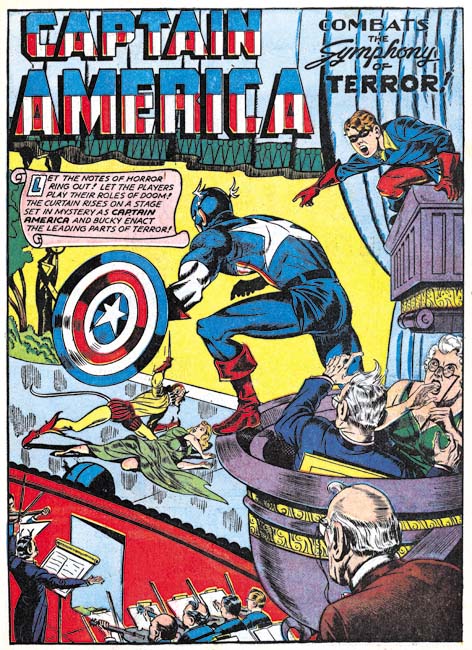
Captain America #11 (February 1942) “The Symphony of Terror”, pencils by Al Avison
Avison learned a lot from Simon and Kirby to the extent that some mistakenly believe that Kirby supplied layouts for some of his work (Al Avison Did Not Need Any Help). Simon and Kirby used irregularly shaped panels when they did Captain America and Avison continued to use them. The art in Simon and Kirby Captain America often extended outside the panel borders and Al kept that device as well. Avison even continued to occasionally provide double page splashes that previously been used so effectively by Joe and Jack.

Captain America #12 (March 1942) “Rozzo the Rebel” page 11, pencils by Al Avison
Simon and Kirby became justly famous for all the wonderful action they put into Captain America. Now I am not going to claim that Avison handled action as well as Joe and Jack, but you can tell he was trying. Not only trying but doing a better job of it than most of his contemporaries. Avison was also keen to try new techniques. For example the page from “Rozzo the Rebel” shown above where Al places three stages of the action into a single page size panel.

Captain America #14 (May 1942) “The Petals of Doom”, pencils by Al Avison, inks by Syd Shores
While Al Avison seemed to have learned a lot from Simon and Kirby, Syd Shores did not learn enough. Shores certainly did most, perhaps all, the inking of Avison’s pencils. Unfortunately Shores had not learned the art of restraint from Simon and Kirby. Too much detailed inking can deaden a piece of comic book art and that is an error that Shore often fell into when inking Captain America. But I do not want to leave the impression that Shores could not do a good job. I particularly admire the splash for “The Petals of Doom”. Despite the over use of fine ink lines, Shores still manages to make the foreground figures stand out. The phantom figure in the background is made more ghostly by the adding white lines over the regular inking lines (probably by dragging the corner of a razor blade).
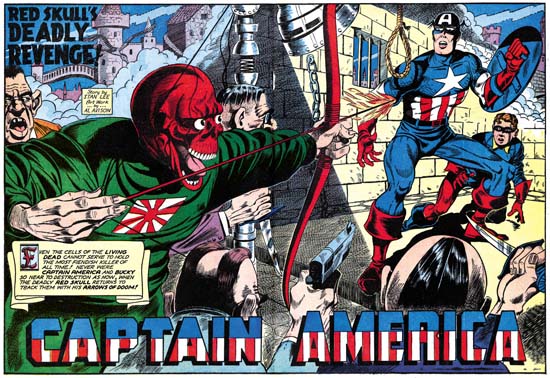
Captain America #16 (July 1942) “Red Skull’s Deadly Revenge”, pencils by Al Avison
Larger Image
As previously mentioned, Stan Lee did not occupy a very high position in the Simon and Kirby studio. His only contribution to the comics were some of the text only features (ignored by almost all readers) and scripts for the backup features. It is clear that Lee made no real contributions to the Captain America featured stories while he was working for Simon. All that changed with the departure of Simon and Kirby. Stan Lee became the editor and would write at least some of the Cap stories. How many of them is an open issue. Some experts claim that Stan Lee signed everything he wrote. However that seems to me to be an extreme position that should be backed up with good evidence. I am unable at this time to hazard a guess whether some of the unsigned Captain America stories were scripted by Lee but fortunately there are also some signed pieces. Perhaps the best was “Red Skull’s Deadly Revenge”. With this story Stan had already advanced beyond most of his peers. It certainly is my favorite golden age Captain America story not done by Simon and Kirby. It has been reprinted not only in the Captain America golden age archives but also in the Stan Lee Visionary volume. “Red Skull’s Deadly Revenge” has a special place in my heart because it was the first piece of comic book art that I ever restored.

Captain America #17 (August 1942) “Sub-Earthmen’s Revenge”, pencils by Al Avison
The Captain America stories are very imaginative. Filled with alligator men, Martians, subsurface dwellers, and other villains. In the end most of the more bizarre advisories would turn out to be a costume wearing Nazi spies. This was very much in keeping with the earlier version by Simon and Kirby.
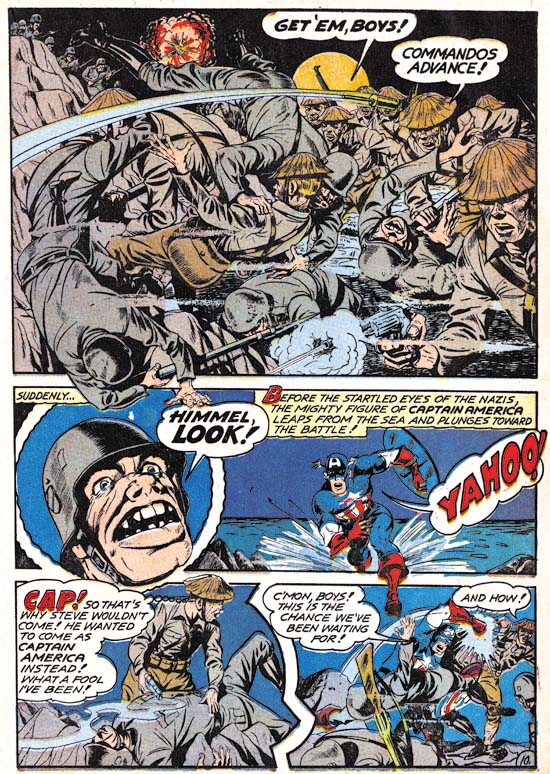
Captain America #19 (October 1942) “On to Berlin” page 10, pencils by Al Avison, inks by Syd Shores
Today Captain America is often called a super-soldier but that description is quite incorrect for the S&K and most Avison stories. Captain America and Bucky fought spies not enemy soldiers. That is until “On to Berlin”. Here Cap joins the storming of a beach. But joining is the proper description, Captain America did not lead the charge. Also note that Cap does not sport a rifle, pistol, knife or other hand weapon. The lack of weaponry is not a response to a moral position against such violence because in panel four there is Bucky (without his superhero costume) holding a recently fired handgun. Neither Simon and Kirby nor Avison every showed Captain America using a hand weapon other than his shield.
Captain America #19 marked Avison’s last issue before he begin his own military service. Starting in the next issue Syd Shores would replace Avison as the primary artist for Captain America. I will discuss Shores contribution next week. I have not forgotten that there are further posts to write in order to finish up my series on Police Trap. All I can say is I do like to mix up the subject of posts. But right now for some inexplicable reason I just cannot get Captain America out of my mind.
Commercial Work by Marvin Stein
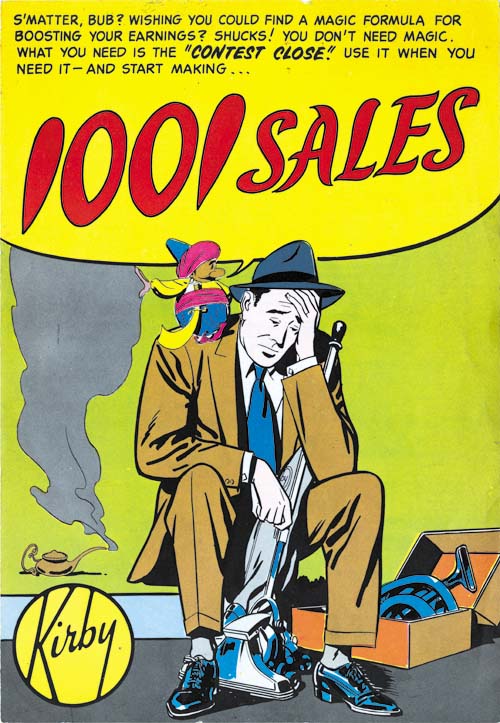
“1001 Sales”, pencils and inks by Marvin Stein
I have to admit when I decided to write a post about some recent commercial comics that I have come across I thought about giving it the title “A Newly Discovered Kirby Comic”. Such a title would surely attract attention and yes the cover to “1001 Sales” has a conspicuously Kirby marking. However it is not Jack Kirby that is referred to but Kirby Vacuum Cleaners. The artist to this commercial comic and two others that I will also discuss was Marvin Stein.
“1001 Sales” is a slim 4 page comic book. Really nothing more than a single sheet that has been folded. The paper is newsprint although perhaps a little better quality than the paper of typical comic books. But otherwise clearly recognizable as a comic book. Political and commercial comics were not that unusual years ago but have are pretty disappeared today.
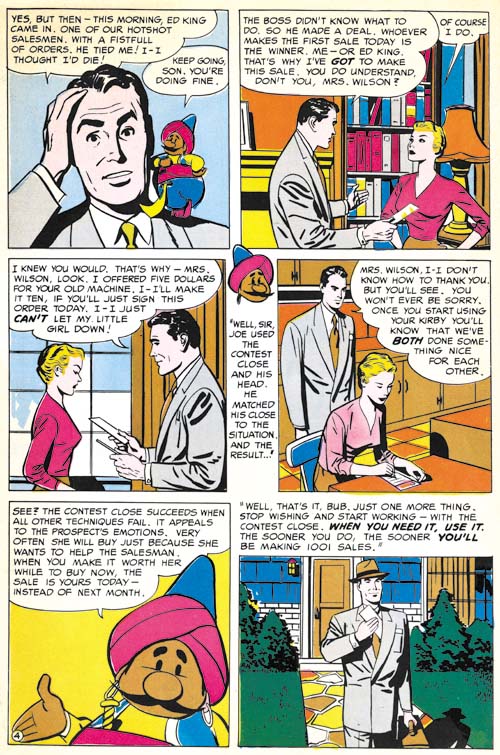
“1001 Sales” page 4, pencils and inks by Marvin Stein
The first page, which passes as a cover, may not be immediately recognizable as drawn by Stein. But this is due to the unusual pose and expression, at least compared to Marvin’s comic book work. But the art style found on the other pages clearly belong to Stein. The art was a bit more polished than his typical comic book work but this is to be expected for commercial publications. Actually Marvin’s commercial art seems much less dry than typical for this type of work as done by other comic book artists. Stein’s inking plays an important part of what makes this work so appealing.
“1001 Sales” is undated and the only marking on it is “produced by Visual Medium Co., Massapequa, N.Y.”. But the style matches Marvin’s work from 1955 to 1958 (after which Stein stopped drawing for comic books) that it was probably executed not long after.
I cannot resists a comment about the theme of “1001 Sales”. This comic was obviously aimed at Kirby salesmen to promote the use of the “contest close”. This was a device to achieve sales by appealing to potential customer’s better natures. Clearly there really was no contest which offered a special doll as a reward for the most sales. The mention of a daughter expecting the salesman to bring home this prize was obviously nothing more than a technique aimed at a customer’s maternal feelings. It really is surprising that such a blatant lie was being used to increase sales. However a check of Consumer Affairs suggest that similarly objectionable techniques may still be used by Kirby sales personal.

“Engin-Surance”, pencils and inks by Marvin Stein
Stein created another comic “Engin-Surance”. Once again a short four page work, that is nothing more than just a folded sheet. This comic is marked as “Litho in U.S.A. by Visual Medium Co., Massapequa, N.Y.”. This is the same company that “produced” the “1001 Sales” comic. This suggests that Visual Medium was not an advertisement agency but the printer.
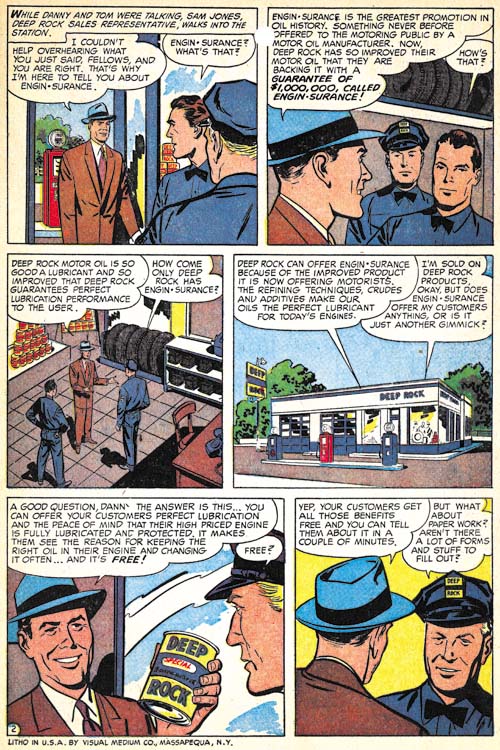
“Engin-Surance” page 2, pencils and inks by Marvin Stein
Once again Marvin Stein’s hand is not as obvious on the cover art as it is in the interior pages but I do believe he did the cover as well. Frankly the art for “Engin-Surance” is nowhere nears as nice as in “1001 Sales”. It suffers from being a bit dry which is a typical failure of commercial art.
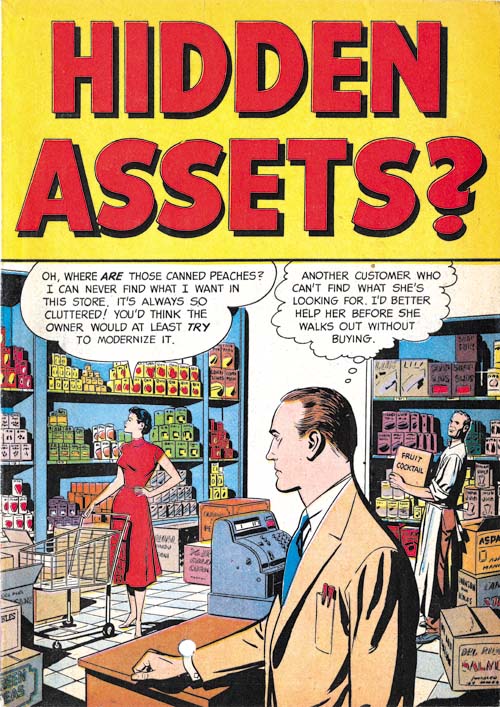
“Hidden Assets?”, pencils and inks by Marvin Stein
The final commercial comic by Marvin Stein that I have come across is “Hidden Assets?”. Unlike the previous examples, this comic is eight pages long. The two sheets that formed the book were not stapled together but rather glued. There are no markings to indicate who produced this comic.

“Hidden Assets?” page 2, pencils and inks by Marvin Stein
The quality of the art falls somewhere between the two previous examples. Note the woman in panel 4. The way her head tilts down and to the side somewhat is a typical Stein pose. Also typical for Marvin is the particular way the perspective does not seemed to be handled quite correctly. The distortion is not enough to make to detract from the beauty of the drawing but enough to be distinctive.
I have seen commercial work by other comic book artists such as George Roussos for General Electric. But I have to say that normally I find the art much too dry for my tastes. But I rather like what Marvin Stein did commercially, particularly “1001 Sales”. Stein never received much recognition but he really was a talented artist.
Police Trap #4

Police Trap #4 March 1955), pencils and inks by Jack Kirby
Another dramatic cover by Jack Kirby but the subject matter (setting oil fires) is not a typical crime. The pose of the fugitive is similar to that used on the cover of Captain America #7 (October 1941). The cover includes a little insert for a story drawn by Jo Albistur (to be discussed below). Such use of inserts is not typical of Simon and Kirby covers but was done on occassion (for instance on Young Romance #12, July 1949). Interestingly the covers refer to the story as “An Honest Day’s Work” although in the interior the story is titled “All in a Day’s Work”.
This cover and In Love #4, which came out in the same month, were the first Mainline titles to have a stamp declaring “another Simon Kirby smash hit”. Simon and Kirby were not mentioned in any of the previously released issues and they did not sign any of the art. Such anonimity, quite unusual for the typcially self promotors, was probably an attempt to minimize conflicts with Prize Comics for whom Simon and Kirby continued to produce titles. However Police Trap #4 and In Love #4 included postal statements listing Joe and Jack as the editors so the gig was now up in any case. The choice of a stamp may have been suggested by the coming Comic Code whose stamp of approval would first appear on the next issue.
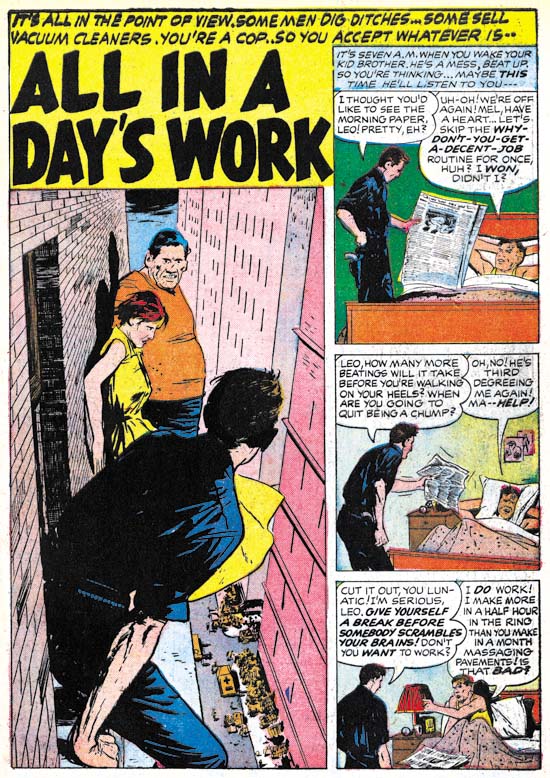
Police Trap #4 March 1955) “All In A Day’s Work”, pencils and inks by Joaquin Albistur
Joanquin Albistur supplied the feature story for this issue, “All In A Day’s Work”. There are a number of features that I find attractive in Albistur’s style all of which are found in this particular story. I particularly like Jo’s careful use of body language and gesture as in the panel with the policeman shaking the newspaper and his brother’s use of the pillow to drown out his lecture. But what really makes this story unique Albistur handling of the skyscraper views. The rendering of the brickwork would normally be overdone but in this case adds much to the effect of the dissy perspectives.
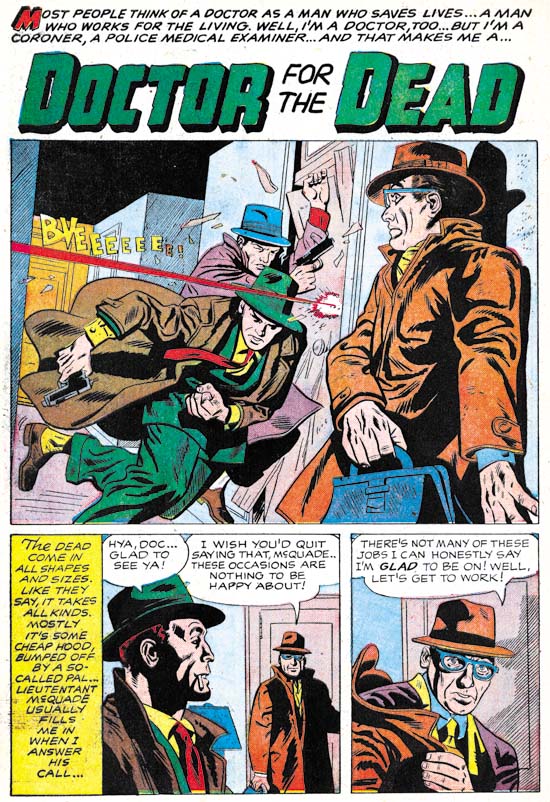
Police Trap #4 March 1955) “Doctor For The Dead”, pencils by an unidentified artist
I may not have identified the artist for “Doctor For The Dead” but that does not mean he did not do a nice job. There are some aspects of the lettering that look unusual for a Simon and Kirby production. For instance the colored ‘M’ that starts the title caption or the scripted ‘T’ from the story caption. Perhaps this is another piece that was picked up from a failed comic book publisher.
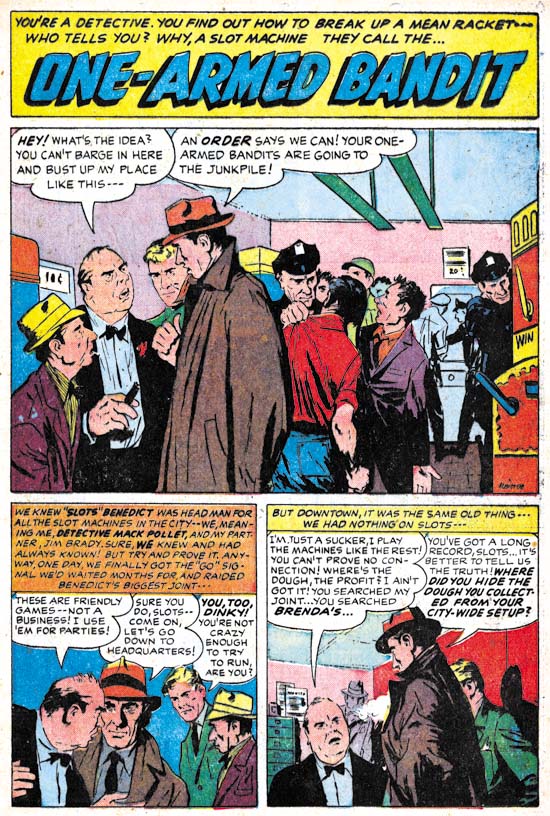
Police Trap #4 March 1955) “One-Armed Bandit”, pencils and inks by Joaquin Albistur
Joaquin Albistur is back as the artist for another story, “One-Armed Bandit”. The splash panel is a great example of why I like this artist so much. The confrontation between a detective and two hoods is all placed on the left side of the panel. You do not need to read the word balloons to determine which of the two criminals is the boss man. The background hardly deserves that term because the figures there are only slightly smaller than the foreground characters. Each person in the splash has their own distinct personality with the exception of the two cops.
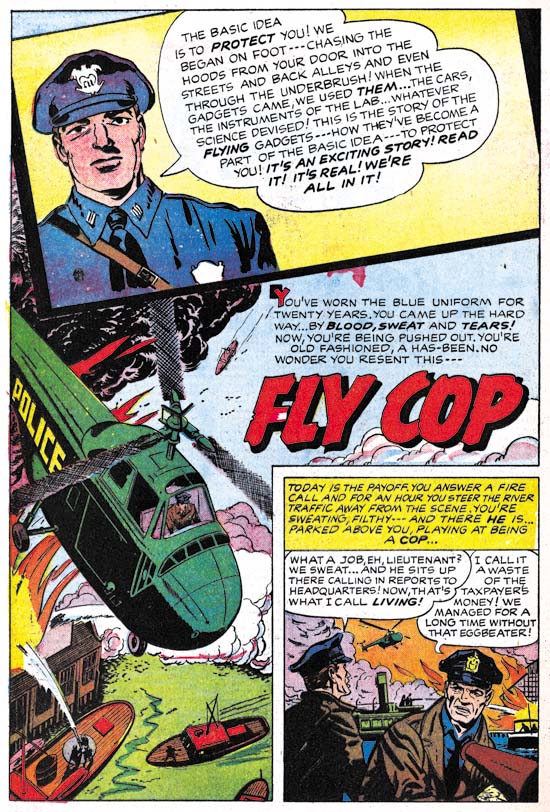
Police Trap #4 March 1955) “Fly Cop”, pencils by an unidentified artist and Jack Kirby
Another unidentified artist provides almost all the art for “Fly Cop”. But there in the insert at the top of the splash page is a contribution by Jack Kirby. Jack often played the role as art director in the Simon and Kirby studio adding and sometime correcting the art drawn by others. Most of the time when this was done Kirby would add something to make the splash page a bit more interesting. Usually Jack would ink these additions himself suggesting that these were last minute alterations. I believe the original art for this page still exists and it would be interesting to see if it shows signs of alterations or whether Kirby’s contribution was planned from the start.



